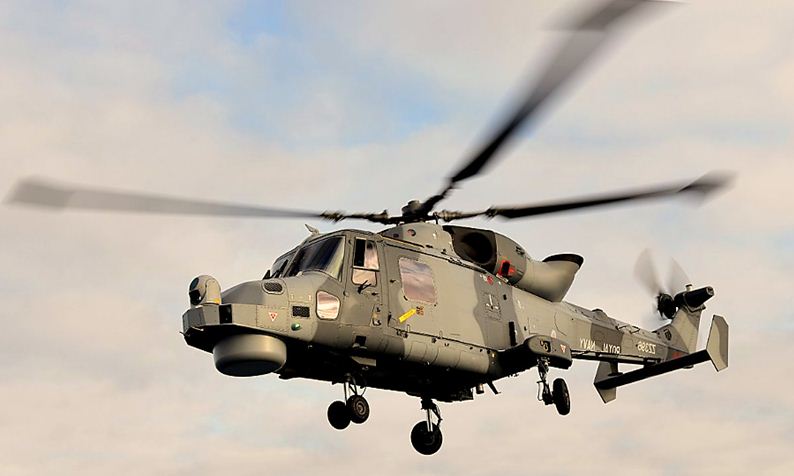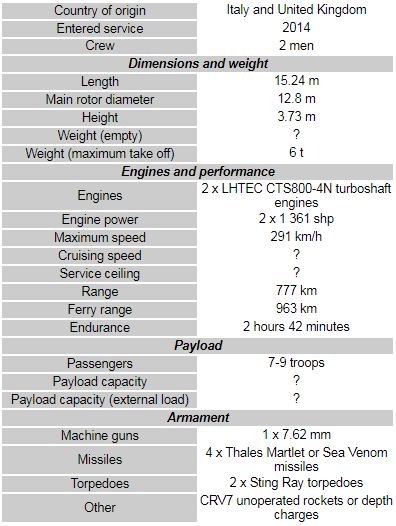 |
| AgustaWestland AW159 |
Militarymedia.net | In 1995 the British Government announced that the Royal Navy's Westland Lynx helicopter would be replaced. In 2002, the Future Lynx project was started. The Westland Super Lynx 300 helicopter was proposed to meet the requirements of the British Army and Royal Navy to replace the aging Lynx helicopter. In 2006 the UK Ministry of Defense awarded a contract for 70 new helicopters. This amount is then deducted back. Production started in 2007.
Until 2009 this new helicopter was named the Lynx Wildcat. However, since 2009 this helicopter has been marketed under the AgustaWestland brand. It should be noted that in 2000 Agusta from Italy and Westland Helicopters from England merged and formed AgustaWestland.
The Super Lynx/AW159 made its first flight in 2009. Initial deliveries began in 2011. There are utility, reconnaissance and anti-surface versions of this multi-role helicopter. In 2014 the AgustaWestland AW159 was officially adopted by the British Army and Royal Navy as the Wildcat where it replaced the old Westland Lynx helicopter. South Korea was the first export customer to order this new helicopter. There the AW159 won the competition against the MH-60R Seahawk. An order for 8 helicopters was made in 2013. These helicopters will be used by the South Korean Navy.
The AW159 is a further development of the highly successful Westland Super Lynx. There are two versions of this multi-role helicopter, intended for the British Army and Royal Navy. Both versions have a common airframe that has a wheeled undercarriage. Several AW159 helicopters are used by British special forces.
The AgustaWestland AW159 is a twin-engine helicopter. Although it looks similar to the Westland Lynx, it has significant design differences. 95% new components and only 5% interchangeable with the latest version of Lynx (AH.7 and HMA.8 variants).
The AW159 is operated by 2 pilots. Can carry 7 to 9 passengers. One of the passengers can operate the machine gun mounted on the door. The army version has a 7.62 mm machine gun, while the naval version is equipped with a much more powerful 12.7 mm machine gun.
The helicopter is powered by two LHTEC CTS800-4N turboshaft engines, producing 1,361 shp each. This engine is manufactured by a joint venture of Rolls-Royce and Honeywell. Certain elements, such as the tail rotor and tail boom, have been redesigned for greater durability and stealth. The new AW159 is a capable machine. The original Westland Lynx is arguably the most capable and versatile helicopter in its class.
The helicopter can carry a CRV7 or other non-operated rocket. It can carry four light multi-role Thales Martlet air-to-surface missiles. Or it can carry four Sea Venom light anti-ship missiles. This weapon is effective against small ships and fast attack ships. Both of these missiles can target ships and land targets. The naval version can also carry two torpedoes or a Sting Ray depth payload.
The AW159 is equipped with advanced avionics circuits and sensors. This helicopter has several defense systems.
 |
| AgustaWestland AW159 |
AgustaWestland AW159 Variant
Wild Cat AH.1. These are referred to as battlefield reconnaissance and attack helicopters, not utility helicopters. A total of 30 were ordered by the British Army. It is also used by the Royal Navy.
Wildcat HMA.2 naval anti-surface and anti-submarine, utility and search and rescue helicopter. It has an Active Electronically Scanned Array (AESA) radar, an electro-optical/infrared device for imaging and targeting. It also has active immersion sonar. A total of 28 were ordered by the Royal Navy. It may be the main Royal Navy ship-based helicopter.
 |
| AgustaWestland AW159 |









